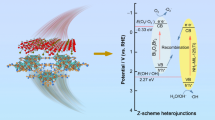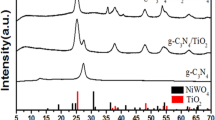Abstract
A Z-scheme heterojunction was constructed by loading (001)-faceted TiO2 onto Bi5O7I through a simple deposition method. Characterization of the obtained photocatalysts included SEM, TEM, XRD, FT-IR, XPS, UV–vis DRS, and PL. The results showed that (001)-TiO2 nanosheets had been successfully anchored to the Bi5O7I nanobelts and the heterojunctions had been formed between them. The catalytic ability of the samples was assessed by degradation of Rhodamine B (RhB). The sample TB-20 exhibited the greatest apparent rate (0.04315 min−1), which was about 3 times that of pure Bi5O7I. The enhanced photocatalytic activity can be attributed to the visible response and charge division of the (001)-TiO2/Bi5O7I composite. The recyclability of the catalyst also showed good stability after four cycles with 90% degradation efficiency. Moreover, the degradation of RhB follows pseudo-first-order kinetics by non-linear least squares fitting to the degradation data. A plausible photocatalytic reaction mechanism has also been presented.






Similar content being viewed by others
References
Long Z, Li Q, Wei T et al (2020) Historical development and prospects of photocatalysts for pollutant removal in water. J Hazard Mater 395:122599–122599. https://doi.org/10.1016/j.jhazmat.2020.122599
Guo F, Huang X, Chen Z et al (2020) Prominent co-catalytic effect of CoP nanoparticles anchored on high-crystalline g-C3N4 nanosheets for enhanced visible-light photocatalytic degradation of tetracycline in wastewater. Chem Eng J 395:125118–125120. https://doi.org/10.1016/j.cej.2020.125118
Ateia M, Alalm MG, Awfa D et al (2020) Modeling the degradation and disinfection of water pollutants by photocatalysts and composites: a critical review. Sci Total Environ 698:0048–9697. https://doi.org/10.1016/j.scitotenv.2019.134197
Fatima R, Afridi MN, Kumar V et al (2019) Photocatalytic degradation performance of various types of modified TiO2 against nitrophenols in aqueous systems. J Clean Prod 231:899–912. https://doi.org/10.1016/j.jclepro.2019.05.292
Al-Mamun MR, Kader S, Islam MS et al (2019) Photocatalytic activity improvement and application of UV-TiO2 photocatalysis in textile wastewater treatment: a review. J Environ Chem Eng 7:103248. https://doi.org/10.1016/j.jece.2019.103248
Cao Y, Yu Y, Zhang P et al (2013) An enhanced visible-light photocatalytic activity of TiO2 by nitrogen and nickel–chlorine modification. Sep Purif Technol 104:256–262. https://doi.org/10.1016/j.seppur.2012.11.030
Kim S, Cho Y, Rhee R et al (2020) Black TiO2: what are exact functions of disorder layer. Carbon Energy 2:44–53. https://doi.org/10.1002/cey2.32
Li K, Zhang Y, Lin YZ et al (2019) Versatile functional porous cobalt-nickel phosphide-carbon cocatalyst derived from a metal-organic framework for boosting the photocatalytic activity of graphitic carbon nitride. ACS Appl Mater Interfaces 11:28918–28927. https://doi.org/10.1021/acsami.9b09312
Sun S, Sun M, Fang Y et al (2016) One-step in situ calcination synthesis of g-C3N4/N-TiO2 hybrids with enhanced photoactivity. RSC Adv 6:13063–13071. https://doi.org/10.1039/c5ra26700e
Mazierski P, Malankowska A, Kobylański M et al (2017) Photocatalytically active TiO2/Ag2O nanotube arrays interlaced with silver nanoparticles obtained from the one-step anodic oxidation of Ti–Ag alloys. ACS Catal 7:2753–2764. https://doi.org/10.1021/acscatal.7b00056
Fu R, Zeng X, Ma L et al (2016) Enhanced photocatalytic and photoelectrochemical activities of reduced TiO2−x/BiOCl heterojunctions. J Power Sources 312:12–22. https://doi.org/10.1016/j.jpowsour.2016.02.038
Cai Q, Wang F, He J et al (2020) Oxygen defect boosted photocatalytic hydrogen evolution from hydrogen sulfide over active 0 0 1 facet in anatase TiO2. Appl Surf Sci 517:146198. https://doi.org/10.1016/j.apsusc.2020.146198
He Y, Yan Q, Liu X et al (2020) Effect of annealing on the structure, morphology and photocatalytic activity of surface-fluorinated TiO2 with dominant 001 facets. J Photochem Photobiol A 393:112400. https://doi.org/10.1016/j.jphotochem.2020.112400
Peng C, Xu W, Wei P et al (2019) Manipulating photocatalytic pathway and activity of ternary Cu2O/(001)TiO2@Ti3C2Tx catalysts for H2 evolution: effect of surface coverage. Int J Hydrogen Energy 44:29975–29985. https://doi.org/10.1016/j.ijhydene.2019.09.190
Wang H, Wu D, Yang C et al (2019) Multi-functional amorphous TiO2 layer on ZIF-67 for enhanced CO2 photoreduction performances under visible light. J CO2 Util 34:411–421. https://doi.org/10.1016/j.jcou.2019.07.011
Liu X, Du G, Li M (2019) True photoreactivity origin of Ti(3+)-doped anatase TiO2 crystals with respectively dominated exposed 001}, {101}, and {100 facets. ACS Omega 4:14902–14912. https://doi.org/10.1021/acsomega.9b01648
Shoja A, Habibi-Yangjeh A, Mousavi M et al (2020) BiOBr and BiOCl decorated on TiO2 QDs: impressively increased photocatalytic performance for the degradation of pollutants under visible light. Adv Powder Technol 31:3582–3596. https://doi.org/10.1016/j.apt.2020.07.002
Wang X, Liu L, An H et al (2019) (Sr0.6Bi0.305)2Bi2O7 as a new visible-light-responsive photocatalyst: an experimental and theoretical study. Mater Res Bull 118: 110484. https://doi.org/10.1016/j.materresbull.2019.05.009
Choi YI, Jeon KH, Kim HS et al (2016) TiO2/BiOX (X=Cl, Br, I) hybrid microspheres for artificial waste water and real sample treatment under visible light irradiation. Sep Purif Technol 160:28–42. https://doi.org/10.1016/j.seppur.2016.01.009
Sharma N, Pap Z, Székely I et al (2021) Combination of iodine-deficient BiOI phases in the presence of CNT to enhance photocatalytic activity towards phenol decomposition under visible light. Appl Surf Sci 565:150605. https://doi.org/10.1016/j.apsusc.2021.150605
Xiao X, Zhang W-D (2011) Hierarchical Bi7O9I3 micro/nano-architecture: facile synthesis, growth mechanism, and high visible light photocatalytic performance. RSC Adv 1:1099. https://doi.org/10.1039/c1ra00323b
Hou J, Wei R, Wu X et al (2018) Lantern-like bismuth oxyiodide embedded typha-based carbon via in situ self-template and ion exchange-recrystallization for high-performance photocatalysis. Dalton Trans 47:6692–6701. https://doi.org/10.1039/c8dt00570b
He R, Cao S, Yu J et al (2016) Microwave-assisted solvothermal synthesis of Bi4O5I2 hierarchical architectures with high photocatalytic performance. Catal Today 264:221–228. https://doi.org/10.1016/j.cattod.2015.07.029
Liu C, Wang XJ (2016) Room temperature synthesis of Bi4O5I2 and Bi5O7I ultrathin nanosheets with a high visible light photocatalytic performance. Dalton Trans 45:7720–7727. https://doi.org/10.1039/c6dt00530f
Wang X, Zhou C, Yin L et al (2019) Iodine-deficient BiOI nanosheets with lowered valence band maximum to enable visible light photocatalytic Activity. ACS Sustain Chem Eng 7:7900–7907. https://doi.org/10.1021/acssuschemeng.9b00548
Dai B, Zhang A, Zhang D et al (2019) Effect of preparation method on the structure and photocatalytic performance of BiOI and Bi5O7I for Hg0 removal. Atmos Pollut Res 10:355–362. https://doi.org/10.1016/j.apr.2018.08.012
Cao J, Li X, Lin H et al (2012) Low temperature synthesis of novel rodlike Bi5O7I with visible light photocatalytic performance. Mater Lett 76:181–183. https://doi.org/10.1016/j.matlet.2012.02.087
Yadav M, Garg S, Chandra A et al (2021) Quercetin-mediated 3-D hierarchical BiOI-Q and BiOI-Q-Ag nanostructures with enhanced photodegradation efficiency. J Alloy Compd 856:156812. https://doi.org/10.1016/j.jallcom.2020.156812
Zhou M, Wu J, Wang H et al (2020) Fabrication of Z-Scheme heterojunction g-C3N4/Yb3+-Bi5O7I photocatalysts with enhanced photocatalytic performance under visible irradiation for Hg0 removal. Energy Fuels 34:16445–16455. https://doi.org/10.1021/acs.energyfuels.0c03368
Sun XY, Zhang X, Sun X et al (2019) Photocatalytic properties of CuO/(001)-TiO2 composites synthesized by the vapor–thermal method. Appl Organomet Chem 33:0268–2605. https://doi.org/10.1002/aoc.5173
Liu X, Chen J, Yang L et al (2022) 2D/2D g-C3N4/TiO2 with exposed (001) facets Z-Scheme composites accelerating separation of interfacial charge and visible photocatalytic degradation of Rhodamine B. J Phys Chem Solids 160:110339. https://doi.org/10.1016/j.jpcs.2021.110339
Zhou X, Wu J, Li Q et al (2017) Carbon decorated In 2 O 3 /TiO 2 heterostructures with enhanced visible-light-driven photocatalytic activity. J Catal 355:26–39. https://doi.org/10.1016/j.jcat.2017.09.006
Wu G, Zhao Y, Li Y et al (2017) Assembled and isolated Bi5O7I nanowires with good photocatalytic activities. CrystEngComm 19:2113–2125. https://doi.org/10.1039/c7ce00439g
Hu Y, Niu Q, Wang Y et al (2021) Highly efficient removal mechanism of dimethyl phthalate over an economical 3D {001}TiO2/Ti photoelectrode with enhanced photoelectrocatalytic activity and long service life. Appl Catal B 285:119812. https://doi.org/10.1016/j.apcatb.2020.119812
Zeng Y, Xu Y, Zhong D et al (2021) BiOBr/Bi5O7I/TiO2/Ti photoanode assembled visible light responsive photocatalytic fuel cell for efficient Rhodamine B degradation and stable electricity generation. ChemistrySelect 6:8912–8918. https://doi.org/10.1002/slct.202102309
Cheng H, Wu J, Tian F et al (2019) Visible-light photocatalytic oxidation of gas-phase Hg0 by colored TiO2 nanoparticle-sensitized Bi5O7I nanorods: enhanced interfacial charge transfer based on heterojunction. Chem Eng J 360:951–963. https://doi.org/10.1016/j.cej.2018.07.093
Lin J, Hu Z, Li H et al (2019) Ultrathin nanotubes of Bi5O7I with a reduced band gap as a high-performance photocatalyst. Inorg Chem 58:9833–9843. https://doi.org/10.1021/acs.inorgchem.9b00858
Zhang H, Zhang X, Zhang Z et al (2021) Ultrahigh charge separation achieved by selective growth of Bi4O5I2 nanoplates on electron-accumulating facets of Bi5O7I nanobelts. ACS Appl Mater Interfaces 13:39985–40001. https://doi.org/10.1021/acsami.1c06188
Malefane ME (2020) Co3O4/Bi4O5I2/Bi5O7I C-scheme heterojunction for degradation of organic pollutants by light-emitting diode irradiation. ACS Omega 5:26829–26844. https://doi.org/10.1021/acsomega.0c03881
Chi Q, Zhu G, Jia D et al (2021) Built-in electric field for photocatalytic overall water splitting through a TiO2/BiOBr P-N heterojunction. Nanoscale 13:4496–4504. https://doi.org/10.1039/d0nr08928a
Jiang Z, Wan W, Wei W et al (2017) Gentle way to build reduced titanium dioxide nanodots integrated with graphite-like carbon spheres: from DFT calculation to experimental measurement. Appl Catal B 204:283–295. https://doi.org/10.1016/j.apcatb.2016.11.044
Guan M, Zhang X, Bao J et al (2019) Two-dimensional ultrathin BiOCl nanosheet/graphene heterojunction with enhanced photocatalytic activity. Nanotechnology 31:085706. https://doi.org/10.1088/1361-6528/ab5535
Xiao X, Xing C, He G et al (2014) Solvothermal synthesis of novel hierarchical Bi4O5I2 nanoflakes with highly visible light photocatalytic performance for the degradation of 4-tert-butylphenol. Appl Catal B 148–149:154–163. https://doi.org/10.1016/j.apcatb.2013.10.055
Yao C, Wang X, Zhao W et al (2020) Probing the facet-dependent intermediate in the visible-light degradation of RhB by carbon-coated anatase TiO2 nanoparticles. J Alloy Compd 846:156335. https://doi.org/10.1016/j.jallcom.2020.156335
Lente G (2018) Facts and alternative facts in chemical kinetics: remarks about the kinetic use of activities, termolecular processes, and linearization techniques. Curr Opin Chem Eng 21:76–83. https://doi.org/10.1016/j.coche.2018.03.007
Sahin M, Gubbuk IH (2022) Green synthesis of palladium nanoparticles and investigation of their catalytic activity for methylene blue, methyl orange and rhodamine B degradation by sodium borohydride. Reac Kinet Mech Cat 135:999–1010. https://doi.org/10.1007/s11144-022-02185-y
Ou Li, Lyu et al (2019) Facet-dependent interfacial charge transfer in TiO2/nitrogen-doped graphene quantum dots heterojunctions for visible-light driven photocatalysis. Catalysts 9:2073–4344. https://doi.org/10.3390/catal9040345
Xia J, Yin S, Li H et al (2011) Improved visible light photocatalytic activity of sphere-like BiOBr hollow and porous structures synthesized via a reactable ionic liquid. Dalton Trans 40:5249–5258. https://doi.org/10.1039/c0dt01511c
Hu L, He H, Xia D et al (2018) Highly efficient performance and conversion pathway of photocatalytic CH3SH oxidation on self-stabilized indirect Z-Scheme g-C3N4/I(3-)-BiOI. ACS Appl Mater Interfaces 10:18693–18708. https://doi.org/10.1021/acsami.8b03250
Wu Z, Liang Y, Yuan X et al (2020) MXene Ti3C2 derived Z–scheme photocatalyst of graphene layers anchored TiO2/g–C3N4 for visible light photocatalytic degradation of refractory organic pollutants. Chem Eng J. https://doi.org/10.1016/j.cej.2020.124921
Xue C, Zhang T, Ding S et al (2017) Anchoring tailored low-index faceted BiOBr nanoplates onto TiO2 nanorods to enhance the stability and visible-light-driven catalytic activity. ACS Appl Mater Interfaces 9:16091–16102. https://doi.org/10.1021/acsami.7b00433
Hu J, Weng S, Zheng Z et al (2014) Solvents mediated-synthesis of BiOI photocatalysts with tunable morphologies and their visible-light driven photocatalytic performances in removing of arsenic from water. J Hazard Mater 264:293–302. https://doi.org/10.1016/j.jhazmat.2013.11.027
Acknowledgements
This work was supported by the National Natural Science Foundation of China: [Grant Number 81974317].
Author information
Authors and Affiliations
Corresponding author
Ethics declarations
Competing Interests
The authors declare no competing interests.
Additional information
Publisher's Note
Springer Nature remains neutral with regard to jurisdictional claims in published maps and institutional affiliations.
Supplementary Information
Below is the link to the electronic supplementary material.
Rights and permissions
Springer Nature or its licensor holds exclusive rights to this article under a publishing agreement with the author(s) or other rightsholder(s); author self-archiving of the accepted manuscript version of this article is solely governed by the terms of such publishing agreement and applicable law.
About this article
Cite this article
Mai, X., Lin, W., Chen, J. et al. Synthesis of Z-scheme (001)-TiO2/Bi5O7I heterojunctions with enhanced interfacial charge separation and photocatalytic degradation of Rhodamine B. Reac Kinet Mech Cat 135, 3447–3459 (2022). https://doi.org/10.1007/s11144-022-02309-4
Received:
Accepted:
Published:
Issue Date:
DOI: https://doi.org/10.1007/s11144-022-02309-4




